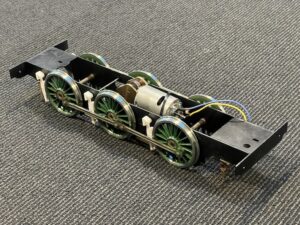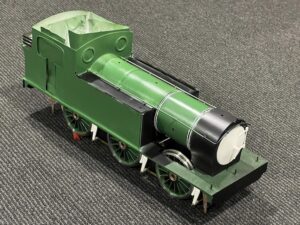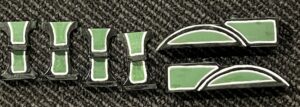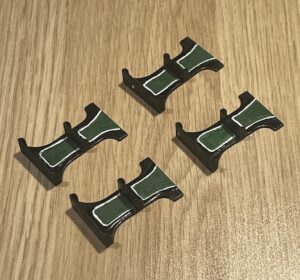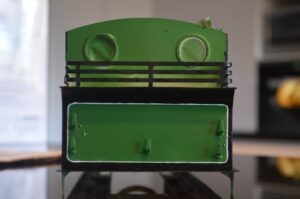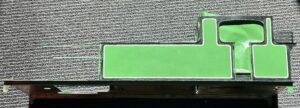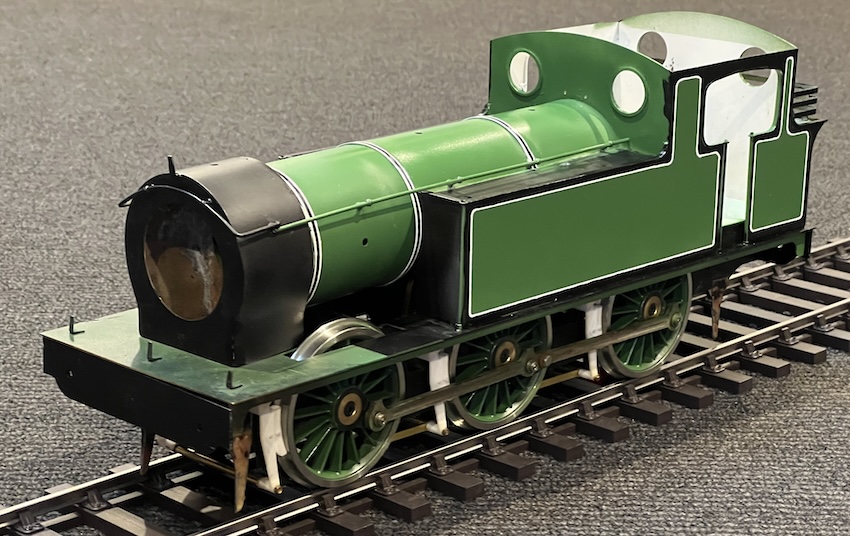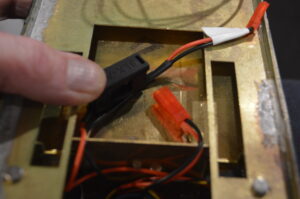I often see models completed except for painting, and very nice they can look all in brass/nickel-silver. However I suspect that doing a kit this way makes the painting/lettering/finishing more difficult. So although I had originally thought that I would make my locomotive that way, the instructions imply that some parts (particularly the boiler) would be easier to paint during construction.
 So I have now painted the boiler and smokebox. I have also had to take all the wheels off to paint the frames (after rubbing off all the corrosion left by the soldering flux).
So I have now painted the boiler and smokebox. I have also had to take all the wheels off to paint the frames (after rubbing off all the corrosion left by the soldering flux).
I have also now fitted the brakes. As one of my fellow-builders has had trouble with the brakes binding on the wheels, I reduced the side-to-side movement by using thin home-make washers on the outside of the frames behind the wheel bosses.
Having started the process of painting part-way through construction, I am going to carry on, particularly as I am doing the lining which will be made more difficult by lots of added details.
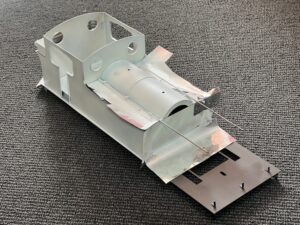 So here is the start of the process of painting the tanks and cab.
So here is the start of the process of painting the tanks and cab.
I made the mistake of using black metal primer on the tanks, having used light-grey primer on the boiler. Using green paint over a different undercoat would show up as different shades of green, so I have had to re-do the green areas with grey primer!
I’m not an expert air-brush operator either, so trying to get right to the edge of colours is tricky – hence the use of masking tape to help with this. I could touch up with a normal brush, but I’m concerned about brush marks, and the effect of the thicker paint that is inevitable if you use a brush. For me, there is no clear answer to this, so I will just have to hope that it won’t be noticeable. With previous models I have used “weathering’ to hide blemishes in the paintwork, but with this model I am hoping that only a small amount of “dirt and grime” will allow the attractive livery to shine through.
****
Here are a couple of pictures after I painted the majority of the areas which are going to be green (and a few areas which will later have to turn black again!). I realise that some areas are uncertain – the front of the water tanks, for instance: green or black? Not terribly important but the prototype picture of G6 number 257 in lined livery is taken from the side, so the fronts of the tanks and the rear of the bunker are mystery areas.
Next is to apply lining to the larger areas, and to the steps below the footplate. My plan was to do the underneath coat in green, as shown above, then to put the white lining on, using a bow-pen and a straight edge (ruler) where possible. I then had to hand draw the curved lines using the bow pen. There were several hopeful thoughts here: firstly that I could draw consistent lines with the bow pen; next that the corners drawn by hand without a guide would be satisfactory; next that blemishes (and I was sure that there would be many!) could be touched up using green paint on the inside of the lines, and black on the outside; and finally that the black outside of the lining would be even although I could not possibly use an airbrush and must hope that the brushmarks will not be obvious.
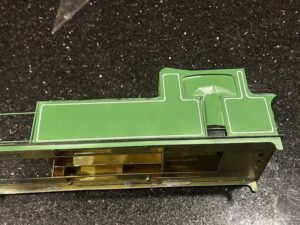 So here is the result of the first attempt at the lines.
So here is the result of the first attempt at the lines.
As part of this process I needed to paint the steps which hang below the footplate. Clearly using a ruler here was not going to be possible and even the small bow-pen would be awkward around the footsteps themselves. Nevertheless it proved to be a good trying-out ground for my scheme.
The left-hand picture (click to enlarge as ever) shows the steps and the wheel valances after my initial attempt. The valances are OK, but the step lining is in my view too thick and uneven.
So I took my bow pen up again, loaded it with green paint and re-painted the inner edges of the lines. I did this also for the outer edges with black paint, and managed to make the lines both thinner and with more even edges (see the RH picture). Don’t look too closely though please: it is a long way from being perfect on close inspection. I’m hoping, though, that on a larger model steam engine like this one, close inspection will not happen too often! Here is a sequence of pistures as I do the lining on the rear of the bunker, showing the process.
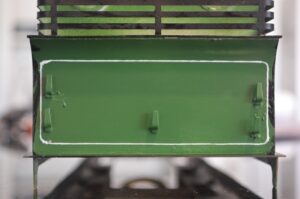 First, putting the white lines on over the even green colouring. The bow pen can be used with a ruler or other straight edge where possible, but clearly the curves at the corners are tricky.
First, putting the white lines on over the even green colouring. The bow pen can be used with a ruler or other straight edge where possible, but clearly the curves at the corners are tricky.
The white lines are deliberately too thick at the corners so that after the 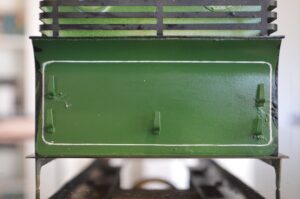 paint has dried I can scrape some off with a scalpel blade.
paint has dried I can scrape some off with a scalpel blade.
I hope to leave green paint showing from beneath the white paint, but if you enlarge the photo., it’s possible to see bare metal in places.
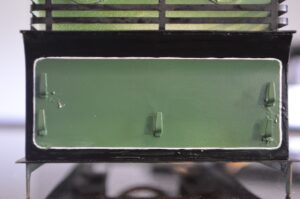 I try to make the bared metal only happen on the outside, because next is using black paint to colour the part outside the white line, right up to the edge of the panel.
I try to make the bared metal only happen on the outside, because next is using black paint to colour the part outside the white line, right up to the edge of the panel.
Some touching up with green is inevitable, though.
Here is the finished object, and below is a picture of the tank sides and cab sides after the same process was used there.
Progress so far …
Now to reinstall the electrics …
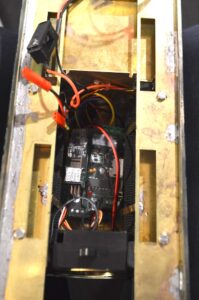 The speaker and the circuit boards I had purchased from Fosworks, and a very good setup it seems to be. My sole criticism is a set of fairly short wires between the on/off switch and recharging socket (which are made to be mounted in the coal bunker) and the rest of the circuits. There are three sets of connectors however which are standard ones and so were easily replaced on longer wiring.
The speaker and the circuit boards I had purchased from Fosworks, and a very good setup it seems to be. My sole criticism is a set of fairly short wires between the on/off switch and recharging socket (which are made to be mounted in the coal bunker) and the rest of the circuits. There are three sets of connectors however which are standard ones and so were easily replaced on longer wiring.
The circuit boards and speaker have to be mounted in the boiler/water-tanks section, and I glued them in place. I decided that the connections could all be made in the space below the footplate in the cab – there is a space there which might even have been designed to take these connections.
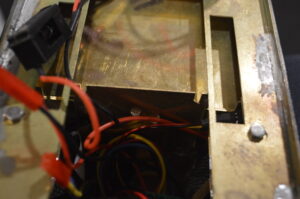 Clearly with the motor in the frames and the batteries, etc., in the superstructure, putting it together will be tricky, or taking it apart. I decided though to make some slots in the brass sheet which is part of the cab front, just to keep the wires well clear of the wheel and frame.
Clearly with the motor in the frames and the batteries, etc., in the superstructure, putting it together will be tricky, or taking it apart. I decided though to make some slots in the brass sheet which is part of the cab front, just to keep the wires well clear of the wheel and frame.
.
This is all aimed to allow relatively easy disassembly, removing the superstructure from the frames, partly because I am far from convinced that it will run easily and smoothly once put together.

